In this post, we will be discussing the topic of how to Enable or Disable Services and how to Start, Stop, Refresh and Restart Services in Windows 11 or Windows 10 using PowerShell, Command Prompt, Task Manager and Net Command.
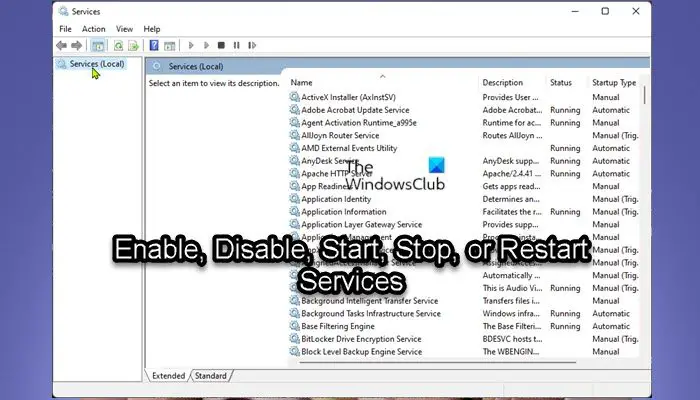
Windows Services are applications that typically start when the computer is booted and run quietly in the background until it is shut down. Essentially, a service is any Windows application that is implemented with the services API and handles low-level tasks that require little or no user interaction.
The Windows OS when installed and running on your device, actually does a great job of automatically managing services, but sometimes you may need to manually enable or disable a service on demand. Keep in mind that if you disable a service, any dependent services are also affected; and enabling a service does not automatically restart its dependent services.
All Windows Services can be accessed after opening the Windows Services Manager and you can Start, Stop, Disable Windows Services using it.
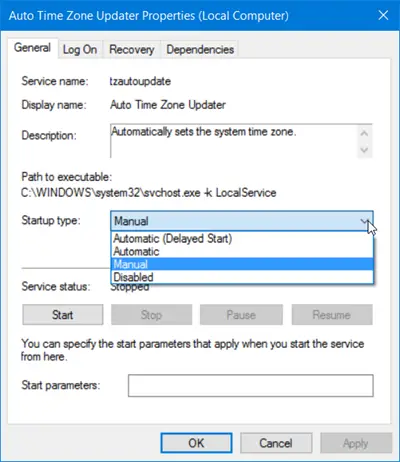
But you can also use PowerShell and Command Prompt to manage Services.
You must be signed in as an administrator to enable and disable services. It is not recommended to disable services unless you know what functions will be affected, and how the system performance will be impacted generally. If you disable a service and you’re unable to access your computer, you can boot into Safe Mode to enable the service.
Before making changes to the services, we recommend you create a system restore point as a necessary precautionary measure in case the procedure causes system malfunction, you can be able to perform System Restore using the restore point to undo the changes.
Use Task Manager to Stop, Restart or Start Windows Services
You can also Stop, Restart or Start Services using the Task Manager.
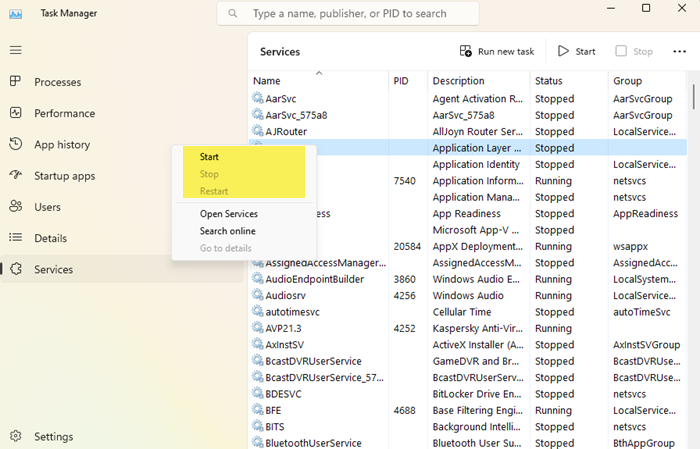
Open the Services tab, right-click on the Service and you will see the available options.
Enable or Disable Windows Services using PowerShell
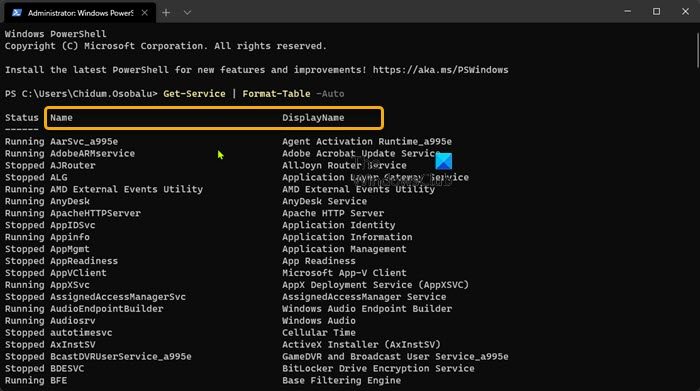
To enable or disable Services using PowerShell in Windows 11/10, do the following:
- Press Windows key + X to open Power User Menu.
- Tap A on the keyboard to launch PowerShell (Windows Terminal) in admin/elevated mode.
- In the PowerShell console, type or copy and paste in the command below and hit Enter to check the current state of all Services:
Get-Service | Format-Table -Auto
To Enable a Service, type the command below you want into the PowerShell console and hit Enter:
Note: Substitute the ServiceName placeholder in each of the commands with the actual service name you want to enable or disable.
(Automatic (Delayed Start))
Set-Service -Name "ServiceName" -StartupType AutomaticDelayedStart
OR
(Automatic)
Set-Service -Name "ServiceName" -StartupType Automatic
OR
(Manual)
Set-Service -Name "ServiceName" -StartupType Manual
To Enable and Start a Service, type the command below you want into the PowerShell console and hit Enter:
(Automatic (Delayed Start))
Set-Service -Name "ServiceName" -StartupType AutomaticDelayedStart -Status Running
OR
(Automatic)
Set-Service -Name "ServiceName" -StartupType Automatic -Status Running
OR
(Manual)
Set-Service -Name "ServiceName" -StartupType Manual -Status Running
To Stop and Disable a Service, type the command below into the PowerShell console and hit Enter:
Set-Service -Name "ServiceName" -StartupType Disabled -Status Stopped
- Exit PowerShell when done.
Enable or Disable Windows Services using Command Prompt
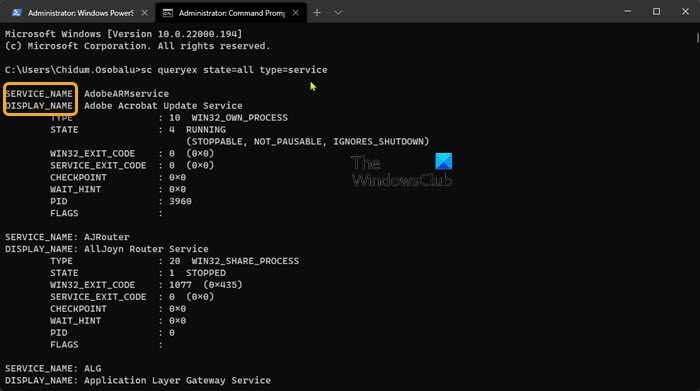
To enable or disable Services using Command Prompt in Windows 11/10, do the following:
- Press Windows key + X to open Power User Menu.
- Tap A on the keyboard to open Windows Terminal in admin/elevated mode.
- Select Command Prompt.
- In the CMD prompt console, type or copy and paste in the command below and hit Enter to check the current state of all Services:
sc queryex state=all type=service
To Enable a Service, type the command below you want into the CMD prompt console and hit Enter:
Note: Substitute the ServiceName placeholder in each of the commands with the actual service name you want to enable or disable.
(Automatic (Delayed Start))
sc config "ServiceName" start=delayed-auto
OR
(Automatic)
sc config "ServiceName" start=auto
OR
(Manual)
sc config "ServiceName" start=demand
To Enable and Start a Service, type the command below you want into the CMD prompt console and hit Enter:
(Automatic (Delayed Start))
sc config "ServiceName" start=delayed-auto && sc start "ServiceName"
OR
(Automatic)
sc config "ServiceName" start=auto && sc start "ServiceName"
OR
(Manual)
sc config "ServiceName" start=demand && sc start "ServiceName"
To Stop and Disable a Service, type the command below into the CMD prompt console and hit Enter:
sc stop "ServiceName" && sc config "ServiceName" start=disabled
- Exit Command Prompt when done.
That’s it!
You must be signed in as an administrator to start, stop, or restart service. Also, you will not be able to start a disabled service until you enable the service.
Start, Stop, or Restart Windows Services using PowerShell
To Start, Stop, or Restart Services in PowerShell in Windows 11/10, do the following:
- Open PowerShell (Windows Terminal) in admin/elevated mode.
To Start a Service, type the command below you want into the PowerShell console and hit Enter:
Note: Substitute the ServiceName and DisplayName placeholder in each of the commands with the actual service name and display name respectively for the Service you want to Start, Stop, or Restart.
Start-Service -Name "ServiceName"
OR
Start-Service -DisplayName "DisplayName"
To Stop a Service, type the command below you want into the PowerShell console and hit Enter:
Stop-Service -Name "ServiceName"
OR
Stop-Service -DisplayName "DisplayName"
To Restart a Service, type the command below you want into the PowerShell console and hit Enter:
Restart-Service -Force -Name "ServiceName"
OR
Restart-Service -Force -DisplayName "DisplayName"
- Exit PowerShell when done.
Start, Stop, or Restart Windows Services in Task Manager
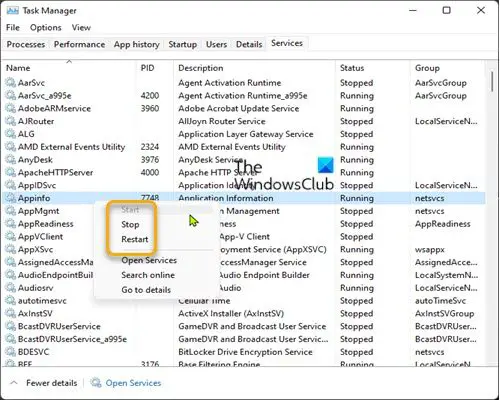
To Start, Stop, or Restart Services in Task Manager in Windows 11/10, do the following:
- Open Task Manager.
- Click/tap on the Services tab.
- Now, right-click or press and hold on a Service.
- Click/tap on Start, Stop, or Restart.
Note: Start will only be available if the service status is currently stopped. Stop and Restart will only be available if the service status is currently running.
- Exit Task Manager when done.
Start, Stop, or Restart Windows Services using Net Command
To Start, Stop, or Restart Services using Net Command in Windows 11/10, do the following:
- Open Windows Terminal in admin/elevated mode.
- Select Command Prompt or PowerShell.
To Start a Service, type the command below you want into the console and hit Enter:
Note: Substitute the ServiceName and DisplayName placeholder in each of the commands with the actual service name and display name respectively for the Service you want to Start, Stop, or Restart.
net start ServiceName
OR
net start "DisplayName"
To Stop a Service, type the command below you want into the console and hit Enter:
net stop ServiceName
OR
net stop "DisplayName"
- Exit Windows Terminal when done.
Start, Stop, or Restart Services using Command Prompt
To Start, Stop, or Restart Services using Command Prompt in Windows 11/10, do the following:
- Open Windows Terminal in admin/elevated mode.
- Select Command Prompt.
To Start a Service, type the command below into the CMD prompt console and hit Enter:
Note: Substitute the ServiceName placeholder in each of the commands with the actual service name for the Service you want to Start, Stop, or Restart.
sc start ServiceName
To Stop a Service, type the command below into the CMD prompt console and hit Enter:
sc start ServiceName
- Exit Command Prompt when done.
How to Refresh a Windows Service?
When you refresh any Windows Service, the contents are re-read into the memory and the changes are reflected the next time the service is accessed. Here’s how you can Refresh a Service:
- Open Services Manager
- Locate the Service you want to refresh
- Right-click on it and select Refresh.
That’s it! Hope you find this post informative and helpful enough.
Read: Services Start, Stop or Startup type grayed out in Windows
What Microsoft startup services can I disable?
There are a couple of Windows 11/10 Services that are safe to disable, including:
- AVCTP service – Disable it if you do not use Bluetooth Audio Device or Wireless Headphones.
- BitLocker Drive Encryption Service – disable it if you do not use BitLocker storage encryption.
- Bluetooth Support Service – Disable it if you do not use any Bluetooth device
- Computer Browser – This will then disable Network discovery of systems on the local network
- Connected User Experiences and Telemetry – Disables Feedback, Telemetry and Data Collection
- Diagnostic Policy Service
- Etc.
Read: Services Start, Stop or Startup type grayed out in Windows
What happens if I disable all Microsoft services?
For example, the wireless services control your Wi-Fi card and if you disable that service, you may be unable to wirelessly connect your Windows 11/10 to a network. Intel has quite a few services which never really hog system resources. Lastly, any graphics card services should remain enabled.
HOT TIP: Windows 11 Repair and Recovery Tool is available FREE for now; go get it while you can as you never know when you may need it!
Leave a Reply